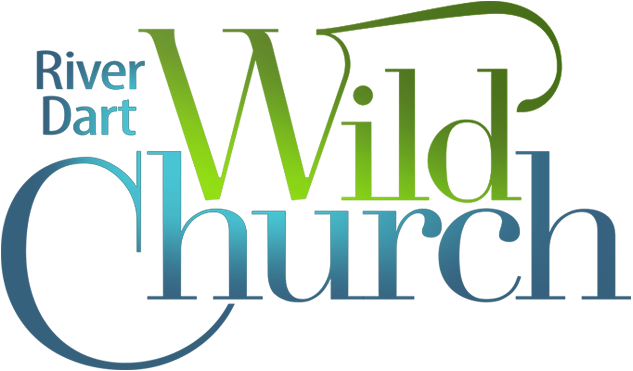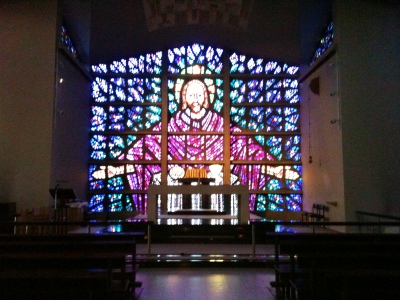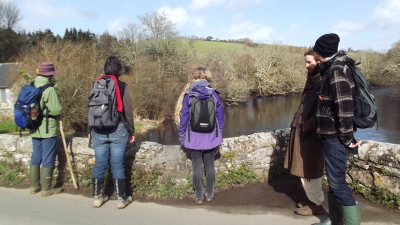
Wild Church set off on its longest pilgrimage to date on the second Sunday of Lent. We started in traditional Church at Dartington which was appropriately austere and freezing cold and so we headed out into the early Spring sunshine with some relief, through Dartington woods and along the river back to Staverton. We passed by Debbie’s Thorpe’s beautiful retreat house, ‘Retreat by the Dart‘, as Debbie joined us for the rest of the journey.
The snowdrops were now in full bloom, alongside some early daffodils, and with hazel catkins dancing in the breeze. And in the churchyard at Staverton there were swathes of delicate crocus in lenten purple.We were warmly welcomed to Sea Trout Mews by Jean Hardy for our ‘bring and share’ lunch. Jean was one of the founder members and former editors of GreenSpirit magazine which promotes an ‘engaged spirituality for a living earth‘ so it was good to visit her, especially with one of the current GreenSpirit editors among us.
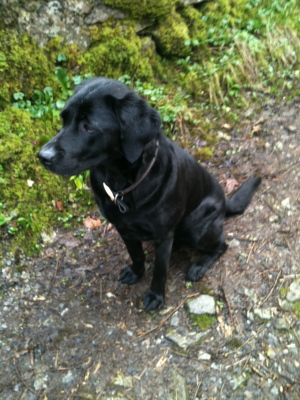
While some of us returned to Schumacher College after lunch, others set off with canine companions for the next stage of our pilgrimage, travelling by steam train along the river to Buckfastleigh. The old railway line runs right beside the river and so gives a good view of river life from goosanders to the sewage works! I (Sam) felt blessed to see a beautiful female goosander with her shaggy brown head diving for food.
The heavens opened on our arrival at Buckfastleigh, so we took shelter at the station cafe and sat outside under the verandah to drink earl grey tea and reflect on Lent. I’ve taken as my theme for this ‘season of the spirit’, a passage I’d heard read at Buckfast Abbey on the previous Sunday from Mark 1:9-13. I was recently writing to the Wood Sisters about my perspective on it, which included bringing it alongside our recent storytelling of the dance between the Cailleach, the old woman of winter, and Bride (or Brigid) the spring maiden, as follows:
The gospel reading for the first Sunday of Lent describes a wonderful shamanic initiation for the young man Jesus as he plunges into a spring pool in the river and is blessed with divine love and spirit power in the form of a dove. He prepares to serve his community through going into the wilderness to face his shadows and fears and is ‘with the wild animals and ministered to by angels’. In the story of Bride we hear a parallel female journey as Bride is blessed by her mother and the Goddess in the form of a bird, has to face her fears and is empowered through sacred waters to bring renewal to her community. Both these stories hold deep spiritual themes in very similar forms and it’s wonderful to place them alongside each other as a sacred marriage of spirit initiations for men and women.
So my lenten practice this year is one of opening day by day to the blessing, teaching and inspiration that comes from the wild animals and angels. Sometimes this happens when I’m outside practising my sacred orientation to the directions & elements… or sometimes on the pilgrimage through the day. Each day, I don’t know in what form this teaching may come. Yesterday my wild animal encounter was through the song of a wren… and my angel was an elderly local woman who I had previously judged and suddenly saw in a new light and realised I had much to learn from. Being present and opening the heart just for a moment can bring surprising blessings!
With Wild Church, I also shared some readings I’d been appreciating from Philip Newel’s ‘Book of Creation‘ from the chapter which celebrates ‘the creatureliness of God‘. Philip quotes from the sixth century Irish monk, Columbanus, who said ‘If you wish to know the Creator, come to know his creatures.’ Columbanus’ mission included the founding of the monastery of Bobio in Italy, where St. Francis later was trained. Philip goes on to tell the story of his house in Iona, Dunsmeorach, meaning hill of the thrush. This was so named because a thrush built her nest in one of the walls when the island men were constructing it and they left off building that wall until her young were fledged. We were similarly inspired by this down to earth tale of reverencing the natural world, which Philip says is also a respect ‘for creation’s wildness and power‘… including of ‘the creaturely depths of who we are‘
We concluded our reflections with one of my favourite poems by St. John of the Cross. He was a remarkable sixteenth century poet and mystic, whom St. Theresa of Avila described as ‘the most angelic human being I have ever encountered.’ In response to his attempted reform of the Carmelite order and his alliance with St. Theresa he was terribly treated by the Church. His story speaks to the spirit of Lent, as he was confined in terrible conditions, starved, tortured by his fellow priests and beaten so badly that he was permanently crippled. Yet in these most awful conditions he had profound visions and experiences of the love of God and went on to write the most beautiful poetry, including the following, from Daniel Ladinsky’s ‘Love Poems from God’:
A Rabbit Noticed My Condition
I was sad one day and went for a walk;
I sat in a field.
A rabbit noticed my condition and came near.
It often does not take more than that to help at times–
to just be close to creatures who
are so full of knowing,
so full of love
that they don’t
– chat,
they just gaze with
their
marvelous understanding.
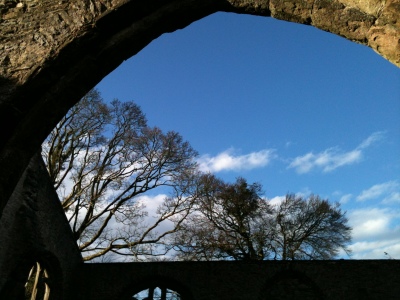
After tea we set off for ‘Fairies Hall’ an old path that leads to the top of Buckfastleigh’s own ‘hollow hill’. Under the now ruined Trinity Church there are several limestone caves, some richly decorated with stalactites & stalagmites, other containing animal bones of hyena, bison and elephants from 125,000 years ago and one which is home to an important colony of horseshoe bats. Coming up to the top of the hill we visited Holy Trinity Church which was the parish church of Buckfastleigh until it was burnt down in the 1990’s. Although this was a traumatic event, a new church, St. Luke’s was then built in the heart of the town and the remains of the 800 year old Trinity Church are a most beautiful wild church with the heavens for a roof and the branches of living trees for vaulting.
Leaving Trinity we walked into the golden light of a sinking sun for the final stage of our sabbath, catching a glimpse of the open moor before descending through fields and woodland to Buckfast Abbey which was glowing golden in the late afternoon light. I stood outside gazing at the moon through the branches of a magnificent old pine tree and then it felt strangely healing to walk into the Abbey which was wonderfully warm and fragrant with frankincense. It was such a pleasure to soak up the silence and light candles to Mother Mary with prayers for friends and for Mother Earth. Our day closed with glimpsing the Christ light through the rich colours of a wall of stained glass in the end chapel before we headed home.
